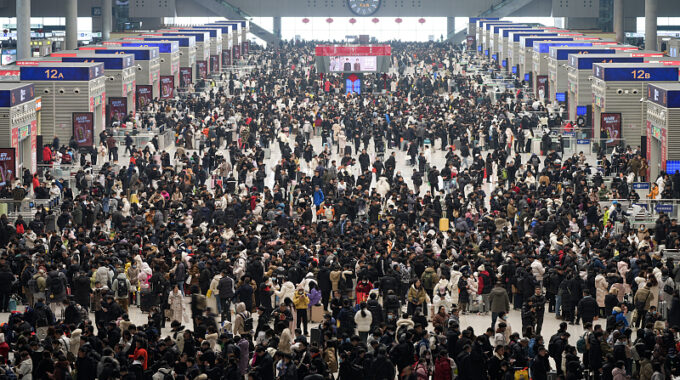How does China cope with huge traffic rush in extreme weather?

Stuck on a highway for over 48 hours, Xu Xue had to wear adult diapers to avoid going to the bathroom and depend on cookies and instant rice to kill hunger as the transport was disrupted by a blizzard and thousands of cars were mired in a terrible traffic jam.
Ahead of the Spring Festival, Xu headed for her hometown in Yichang, a city in central China’s Hubei Province from Shenzhen, a city in south China’s Guangdong Province. It usually takes her about 15 hours to get home by car, but this time, she was stuck in traffic congestion for over 48 hours.
Like Xu, many Chinese were impacted by snowstorms, freezing rain and other extreme weather during China’s New Year travel period. According to officials, a record nine billion trips are expected to be made during this year’s Spring Festival travel rush, which started on January 26 and will last until March 5, and more than 90 percent will be made by road.
Extreme weather and disrupted traffic
China’s National Meteorological Center (NMC) forecast on January 28 that over 15 provinces in the central and eastern parts of China would be affected by the blizzards, heavy snowfall, freezing rain, thunder and lightning. It renewed an orange alert on Sunday for snowstorms in some parts of China, predicting heavy snow in provinces including Henan, Anhui, Jiangsu and Shandong.
In Hubei Province, freezing rain and snow over the past few days have disrupted flights and railway traffic in several cities, including Wuhan, the provincial capital and a transportation hub. In the eastern province of Anhui, over 95 highway toll stations have closed as of Sunday morning, due to snowy and freezing conditions. In Hefei, the provincial capital, authorities have closed three main coach stations while mobilizing more than 300 units of machinery and vehicles to clear snow.
As this round of rainy and snowy weather coincides with the peak of the Spring Festival travel rush, meteorological experts have suggested that preparations should be made in advance for emergencies, and traffic safety, urban operations and other management work should be strengthened. In addition, inspections on the power and communication facilities should also be conducted regularly in affected localities, experts say.
China suffered extremely severe weather-related disasters during the 2008 Spring Festival travel rush, which left more than 5.8 million passengers stranded and disrupted necessities such as water and power supply for more than 100 million people, according to the China Media Group.
However, this year’s extreme weather will not be comparable to the winter storms of early 2008, according to the NMC. It said that this winter’s rainy and snowy process occurred in different areas, that its duration is shorter, and that temperatures would not be as low as in 2008.
Government responses
The Chinese government has repeatedly called for safeguarding safety and social stability ahead of the Chinese New Year. Chinese Premier Li Qiang on Sunday called to improve the country’s ability to respond to emergencies and urged the Emergency Management Ministry to do their utmost to reduce the adverse impacts of extreme weather.
The ministry revealed on Sunday that with the support of the Finance Ministry, it had allocated 4.846 billion yuan of relief funds to 26 provinces, autonomous regions and municipalities at the end of 2023. And 370,000 disaster relief materials such as quilts had also been sent to disaster-hit regions. Besides, 312 million yuan of provincial funds have been distributed to 18 provinces and 775,000 pieces of provincial-level supplies have been given to people in 14 provinces.
To ensure the relief funds are distributed to the affected people effectively, the ministry also sent 10 working groups to 18 key provinces to guide and supervise the relief work. As of January 27, the central relief funds and materials have been fully distributed, benefiting a total of 30.8 million affected people, according to the ministry.
Facing the huge human migration in the extreme weather, the Ministry of Transport, together with the Ministry of Public Security, has published eight measures to ensure road travel during the holiday, including dredging congested sections, free passage in toll stations, road clearing and rescue. It also provided a WeChat mini-program, a sub-application, enabling people to check nearby charging stations, send out distress calls, make complaints and so on.
Besides, highway service areas were asked to strengthen their management, including adding mobile toilets and mobile charging facilities in large traffic service areas, arranging special personnel to guide vehicles to park, charge and refuel, and increasing the supply of food and necessities to reduce congestion. Railways and flights were also asked to increase passenger capacities, check facilities, optimize ticketing systems and release information timely.
Despite the challenging conditions, forecasters say the situation will improve after February 8, as clear weather sets in along the Yangtze River and its northern regions, offering some relief to travelers.








Comments